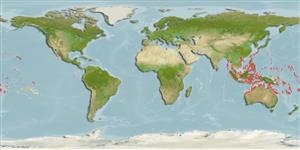Common names from other countries
>
Gobiiformes (Gobies) >
Microdesmidae (Wormfishes) > Microdesminae
Etymology: Gunnellichthys: From Gunnel, a small eel shaped marine fish of unknown origin, 1686 (Ref. 45335).
More on author: Bleeker.
Environment: milieu / climate zone / depth range / distribution range
Ökologie
seewasser riff-verbunden; tiefenbereich 3 - 15 m (Ref. 90102), usually 3 - ? m (Ref. 1602). Tropical; 22°C - 27°C (Ref. 27115); 30°N - 24°S
Western Central Pacific: Java and the Philippines to western Samoa, north to the Ryukyu Islands, south to Rowley Shoals and the southern Great Barrier Reef. Throughout Micronesia.
Size / Gewicht / Alter
Maturity: Lm ? range ? - ? cm
Max length : 12.0 cm SL Männchen/unbestimmt; (Ref. 48637)
Kurzbeschreibung
Bestimmungsschlüssel | Morphologie | Morphometrie
Rückenflossenstacheln (insgesamt) : 20 - 21; Rückenflossenweichstrahlen (insgesamt) : 38 - 41; Afterflossenstacheln: 0; Afterflossenweichstrahlen: 36 - 40.
Inhabits shallow, flat and sandy areas (Ref. 1602). Solitary or in pairs (Ref. 90102). Found near seagrass or mangrove habitats (Ref. 48637). Often less than 3 m, sometimes over 8 m depth (Ref. 1602).
Life cycle and mating behavior
Maturities | Fortpflanzung | Spawnings | Egg(s) | Fecundities | Larven
Myers, R.F., 1991. Micronesian reef fishes. Second Ed. Coral Graphics, Barrigada, Guam. 298 p. (Ref. 1602)
IUCN Rote Liste Status (Ref. 130435)
CITES (Ref. 128078)
Not Evaluated
Bedrohung für Menschen
Harmless
Nutzung durch Menschen
Fischereien: kommerziell; Aquarium: Kommerziell
Tools
Zusatzinformationen
Download XML
Internet Quellen
Estimates based on models
Preferred temperature (Ref.
115969): 25.2 - 29.3, mean 28.6 (based on 2256 cells).
Phylogenetic diversity index (Ref.
82804): PD
50 = 0.5078 [Uniqueness, from 0.5 = low to 2.0 = high].
Bayesian length-weight: a=0.00389 (0.00180 - 0.00842), b=3.12 (2.94 - 3.30), in cm Total Length, based on all LWR estimates for this body shape (Ref.
93245).
Trophic level (Ref.
69278): 3.3 ±0.4 se; based on size and trophs of closest relatives
Fishing Vulnerability (Ref.
59153): Low vulnerability (10 of 100).
